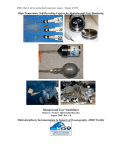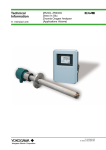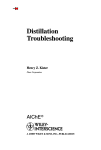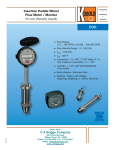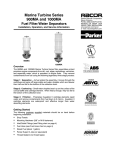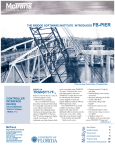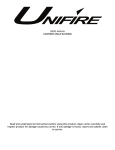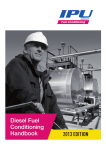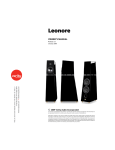Download Troubleshooting Process Plant Control
Transcript
Troubleshooting Process Plant Control Norman P. Lieberman A John Wiley & Sons, Inc., Publication Troubleshooting Process Plant Control Troubleshooting Process Plant Control Other Books by Norman P. Lieberman • Troubleshooting Refinery Operations—Penn Well Publications • Troubleshooting Process Operations 4th Edition—PennWell Publications • A Working Guide to Process Equipment (with E. T. Lieberman)—3rd Edition—McGraw Hill Publications • Troubleshooting Natural Gas Processing (order by e-mail at norm@ lieberman-eng.com) • Process Design for Reliable Operations 3rd Edition (order by e-mail at [email protected]) Copies of the first three texts are best ordered from the publishers, but may be ordered through us. E-mail ([email protected]). Troubleshooting Refinery Operations (1980) has been incorporated into Troubleshooting Process Operations and Troubleshooting Natural Gas Processing. Troubleshooting Process Plant Control Norman P. Lieberman A John Wiley & Sons, Inc., Publication DISCLAIMER Company names and the names of individuals used in this book are entirely fictitious. I have selected company names and the names of colleagues entirely at random. Technically, the stories I have related are correct but are sometimes combinations of actual incidents. Any similarity to actually existing events, process plants, or individuals is purely a coincidence. Also, I sometimes have related projects executed by operators or other engineers as if I had myself originated, rather than just participated in, such events. I have consistently failed throughout this text to assign credit to other individuals for their ideas, which I have not stolen but only borrowed. Any names of actual individuals or process plants or refineries have been chosen at random and do not correspond to any real events connected with the people or locations mentioned in my text. Norman P. Lieberman Copyright © 2009 by John Wiley & Sons, Inc. All rights reserved Published by John Wiley & Sons, Inc., Hoboken, New Jersey Published simultaneously in Canada No part of this publication may be reproduced, stored in a retrieval system, or transmitted in any form or by any means, electronic, mechanical, photocopying, recording, scanning, or otherwise, except as permitted under Section 107 or 108 of the 1976 United States Copyright Act, without either the prior written permission of the Publisher, or authorization through payment of the appropriate per-copy fee to the Copyright Clearance Center, Inc., 222 Rosewood Drive, Danvers, MA 01923, (978) 750-8400, fax (978) 750-4470, or on the web at www.copyright.com. Requests to the Publisher for permission should be addressed to the Permissions Department, John Wiley & Sons, Inc., 111 River Street, Hoboken, NJ 07030, (201) 748-6011, fax (201) 748-6008, or online at http://www.wiley.com/go/permission. Limit of Liability/Disclaimer of Warranty: While the publisher and author have used their best efforts in preparing this book, they make no representations or warranties with respect to the accuracy or completeness of the contents of this book and specifically disclaim any implied warranties of merchantability or fitness for a particular purpose. No warranty may be created or extended by sales representatives or written sales materials. The advice and strategies contained herein may not be suitable for your situation. You should consult with a professional where appropriate. Neither the publisher nor author shall be liable for any loss of profit or any other commercial damages, including but not limited to special, incidental, consequential, or other damages. For general information on our other products and services or for technical support, please contact our Customer Care Department within the United States at (800) 762-2974, outside the United States at (317) 572-3993 or fax (317) 572-4002. Wiley also publishes its books in a variety of electronic formats. Some content that appears in print may not be available in electronic formats. For more information about Wiley products, visit our web site at www.wiley.com. Library of Congress Cataloging-in-Publication Data: Lieberman, Norman P. Troubleshooting process plant control / Norman P. Lieberman. p. cm. ISBN 978-0-470-42514-5 (cloth) 1. Petroleum refineries–Maintenance and repair. I. Title. TP690.3.L534 2009 665.5028′8–dc22 2008032181 Printed in the United States of America 10 9 8 7 6 5 4 3 2 1 Dedication One of life’s little pleasures is working with quality and dedicated people, such as April Montecino Winn and Phil Negri. Persistently and consistently they have worked with my wonderful draftsman, Roy Williams, to bring order to my scribbled manuscript and illegible drawings to produce this book. Inspired by the Creator, these three wonderful people have brought Order out of Chaos. I, too, have been inspired by my equally wonderful partner in life, Liz. She is a light unto my life. v Contents PREFACE ix INTRODUCTION—A HISTORY OF POSITIVE FEEDBACK LOOPS xi Chapter 1 Learning from Experience 1 Chapter 2 Process Control Parameter Measurement 9 Chapter 3 Dependent and Independent Variables 21 Chapter 4 Binary Distillation of Pure Components 29 Chapter 5 Distillation Tower Pressure Control 37 Chapter 6 Pressure Control in Multicomponent Systems 51 Chapter 7 Optimizing Fractionation Efficiency by Temperature Profile 59 Chapter 8 Analyzer Process Control 67 Chapter 9 Fired Heater Combustion Air Control 75 Chapter 10 Sizing Process Control Valves 85 Chapter 11 Control Valve Position on Instrument Air Failure 93 Chapter 12 Override and Split-Range Process Control 101 Chapter 13 Vacuum System Pressure Control 107 Chapter 14 Reciprocating Compressors 115 Chapter 15 Centrifugal Compressor Surge vs. Motor Over-Amping 123 vii viii CONTENTS Chapter 16 Controlling Centrifugal Pumps 131 Chapter 17 Steam Turbine Control 139 Chapter 18 Steam and Condensate Control 147 Chapter 19 Function of the Process Control Engineer 155 Chapter 20 Steam Quality and Moisture Content 163 Chapter 21 Level, Pressure, Flow, and Temperature Indication Methods 179 Chapter 22 Alarm and Trip Design for Safe Plant Operations 195 Chapter 23 Nonlinear Process Responses 205 ABOUT MY SEMINARS 213 FURTHER READINGS ON TROUBLESHOOTING PROCESS CONTROLS 217 THE NORM LIEBERMAN VIDEO LIBRARY OF TROUBLESHOOTING PROCESS OPERATIONS 219 INDEX 221 PREFACE WARNING: The Surgeon General Has Determined That This Book Is a Fraud Dr. R. K. Sudkamp, Ph.D., having reviewed this text, reports that this book’s claim to be a technical work on the exalted subject of Process Control has no basis. Further, findings by the Federal Communications Commission have determined that this book cannot claim to be a Process Control text as enumerated below: • • • The entire book is free of complex mathematics. Even simple equations are rarely encountered. The text is much too easy to read for any respectable technical book. Much of the so-called “advanced technology” described by the author is 40 years old and is already in widespread practice in the process industry. While Professor Sudkamp notes the potential usefulness of this book to solve practical plant process problems, he also observes this is more than offset by its total lack of applicability as a postgraduate university text. Professor Sudkamp, of the University of Stockholm, has reported a deep loss of personal dignity as a consequence of his exposure to Mr. Lieberman’s book, which he considers to be an insult to his lofty intellect. ix Introduction— A History of Positive Feedback Loops Process Control Engineering is the most important branch of Chemical Engineering. Ask any panel board operator in a petrochemical plant or refinery. The P&IDs (Process and Instrumentation Diagrams) are the definitive engineering documents describing how a plant works. The Process Control Engineer has the ultimate responsibility for creating, maintaining, and interpreting the P&IDs. It is his job—and perhaps his most important function—to explain to the panel operator how the control valves interact with the process plant to achieve unit stability. I don’t know why I wrote “his job,” because half of the Process Control Engineers I work with are women. Women often make better control engineers and panel board operators than men, because they are more patient. Men often are driven to reach some distant goal quickly. Women, being patient, will take a more measured approach to restore stability during a process upset. For example, one question I am frequently asked by younger male process engineers and console operators is how to meet girls. One fellow, Jake, described his problem. “I met this lady at a bar, Norm. I introduced myself and asked her name.” “Hi, I’m Linda.” “Can I buy you a drink, Linda?” “Actually, Jake, I’m perfectly capable of buying my own drink.” “Norm, I hate when girls blow me off like that. I couldn’t think what else to say.” xi xii INTRODUCTION—A HISTORY OF POSITIVE FEEDBACK LOOPS “Okay, Jake. Here’s the correct line,” I advised. “Say Linda, I’m conducting a survey. Which is better, negative feedback or positive feedback?” “Well, Jake,” Linda will answer, “I’m a positive-thinking person. Therefore I’m sure that positive feedback is best.” “Not so, Linda,” you’ll say, “As a highly paid Process Control Engineer I’ve found negative feedback is best. Do you mind if I explain?” “Okay, Jake,” she’ll say, “Maybe I will have a small scotch and soda.” “Let’s say, Linda, you’re driving your car uphill. The car is in automatic cruise control. As the gradient increases, the car slows. The gas pedal is automatically depressed to accelerate the car. But as the car engine slows, the amount of combustion air drawn into the engine is reduced. As the air flow drops, the incremental gasoline injected into the cylinders does not burn. But as the gasoline vaporizes, it also cools the engine’s cylinders. This reduces the cylinder pressure and hence the force acting on the pistons heads. This decreases the engine horsepower. The engine and car both slow further. This signals the automatic cruise control to inject more gasoline into the cylinders. As the engine is already limited by combustion air and not by fuel, the extra gasoline just makes the problem worse. If you don’t switch off the cruise control and return to manual operation, the car will stall out and the engine will flood with gasoline. “The problem, Linda, is positive feedback. The loss of engine speed reduced the air flow to the engine and also automatically caused more gasoline to flow into the engine. The problem fed upon itself. That’s why we call this a positive feedback loop. What the Process Control Engineer wants is negative feedback. For a negative feedback loop to work, the engine cannot be limited by the combustion air flow.” “Linda, I run into this problem all the time. It happens in distillation towers, vacuum jet systems, and fired heaters. You see, control loops for process equipment only function properly when they are running in the range of a negative feedback response. Positive feedback is dangerous in that it leads to process instability.” Jake has subsequently tried this approach with Gloria, Janet, and Carol, all with the same result. When he comes to the part about process instability, each lady suddenly remembers an important appointment and rushed out of the bar. NOTE TO READERS I’ve written this book for three groups of people: • • The experienced plant panel board operator The Process Control Engineer who, with his degree in hand, must now face up to the real world INTRODUCTION—A HISTORY OF POSITIVE FEEDBACK LOOPS • xiii The Process Engineer who must design control loops for new or revamped units The text is very basic and very simple. Lots of new control concepts are presented. But they are all based on old technical concepts. Likely, you are reading this text because you are one of the 12,000 students who have already attended one of my seminars, or read one of my other books, or viewed my videotapes on process technology. If not, let me tell you something about myself. My descriptions about control loops, process control optimization, process instrumentation, and control valves in this book are based on my personal experience which encompasses 44 years. Except for the story about Linda and Jake. I just made that up. LATER THAT EVENING My wife and partner, Liz, has just read the story about Linda and Jake. Liz says, “Can’t you give an example of a positive feedback loop without all of the sexist stupidity?” Okay, I will: • • • • • • • • • CO2 accumulates in the atmosphere. The rate of CO2 accumulation between 1968 and 2008 was 0.51% compounded annually. Global warming has increased by 1 °F since the early 1900s, including the surface of the oceans. For the 1960–2000 period, sulfur emissions from oil and coal combustion generated atmospheric sulfates, which reflected sunlight and suppressed global warming. Sulfates are scrubbed from the atmosphere by rain every year. Sulfur emissions in the past decade have mostly been stopped, and the rate of global warming has increased. Only 60% of the CO2 generated from combustion of oil, gas, coal, and cement production has been accumulating in the atmosphere. The rest is absorbed in ocean surface waters. The ocean surface water is becoming more acidic and hotter. Both factors reduce the solubility of CO2 in water. As the land becomes warmer, ice and snow melt in Greenland and the Antarctic. The Earth becomes less reflective to sunlight. As the Earth becomes warmer, methane emissions from frozen tundra, peat bogs, and offshore hydrate deposits increase. Methane per mole is 23 times more powerful a greenhouse gas than CO2. xiv • • • • INTRODUCTION—A HISTORY OF POSITIVE FEEDBACK LOOPS In the next few decades the ocean surface waters will become an emitter rather than an absorber of CO2 because of warming and increased acidity. Accumulating CO2, has in the absence of increased sulfate concentration in the atmosphere, accelerated global warming. Accelerating global warming will reduce the absorption capacity of the ocean surface waters for CO2 and increase methane emissions. Warmer global temperature will increase humidity. Water is a bigger greenhouse gas than either CO2 or methane. The humidity effect will build upon itself.1 Liz, that’s a real positive feedback loop. But I don’t think Jake will get very far in finding a new girlfriend with this grim tale of global warming. Especially if Jake tells Linda the end of the story. Eventually the small percentage of ocean surface waters that have warmed and become acidic will mix with deeper, cooler, neutral pH layers of the ocean, which contain the vast bulk of the planet’s water. This will stop the positive feedback loop and global warming. So my story does have a happy ending—if Linda and Jake can just wait a few thousand years. REFERENCE 1 Desonie, Dana, “Climate—Our Fragile Planet,” Chelsea House Publishers, 2006. 1 Learning from Experience An old Jewish philosopher once said, “Ask me any question, and if I know the answer, I will answer it. And, if I don’t know the answer, I’ll answer it anyway.” Me too. I think I know the answer to all control questions. The only problem is, a lot of my answers are wrong, I’ve learned to differentiate between wrong and right answers by trial and error. If the panel board operator persistently prefers to run a new control loop I’ve designed in manual, if he switches out of auto whenever the flow becomes erratic, then I’ve designed a control strategy that’s wrong. So, that’s how I’ve learned to discriminate between a control loop that works and a control strategy best forgotten. Here’s something else I’ve learned. Direct from Dr. Shinsky, the world’s expert on process control: • • “Lieberman, if it won’t work in manual, it won’t work in auto.” “Most control problems are really process problems.” I’ve no formal training in process control and instrumentation. All I know is what Dr. Shinsky told me. And 44 years of experience in process plants has taught me that’s all I need to know. Troubleshooting Process Plant Control, by Norman P. Lieberman Copyright © 2009 John Wiley & Sons, Inc. 1 2 LEARNING FROM EXPERIENCE LEARNING FROM PLANT OPERATORS My first assignment as a Process Engineer was on No. 12 Pipe Still in Whiting, Indiana. This was a crude distillation unit. My objective was to maximize production of gas oil, as shown in Figure 1-1. The gas oil had a product spec of not more than 500 ppm asphaltines. The lab required half a day to report sample results. However, every hour or two the outside operator brought in a bottle of gas oil for the panel board operator. The panel operator would adjust the wash oil flow, based on the color of the gas oil. While plant supervision monitored the lab asphaltine sample results, plant operators ignored this analysis. They adjusted the wash oil rate to obtain a clean-looking product. The operators consistently produced a gas oil product with 50–200 ppm asphaltines. They were using too much wash oil. And the more wash oil used, the lower the gas oil production. I mixed a few drops of crude tower bottoms in the gas oil to obtain a bottle of 500 ppm asphaltine material. I then instructed the panel board operators as follows: • • • If the sample from the field is darker than my standard bottle, increase the wash oil valve position by 5%. If the sample of gas oil from the field is lighter than my standard, decrease the wash oil valve position by 3%. Repeat the above every 30 minutes. The color of gas oil from a crude distillation unit correlates nicely with asphaltine content. The gas oil, when free of entrained asphaltines, is a pale yellow. So it seems that my procedure should have worked. But it didn’t. The operators persisted in drawing the sample every one to two hours. Figure 1-1 Adjusting wash oil based on gas oil color LEARNING FROM FIELD OBSERVATIONS 3 So, I purchased an online colorimeter. The online colorimeter checked whether the gas oil color was above or below my set point. With an interval of 10 minutes it would move the wash oil valve position by 1%. This never achieved the desired color, but the gas oil product was mixed in a tank. The main result was that gas oil production was maximized consistent with the 500 ppm asphaltine specification. One might say that all I did was automate what the operators were already doing manually, that all I accomplished was marginally improving an existing control strategy by automating the strategy. But in 1965 I was very proud of my accomplishments. I had proved, as Dr. Shinsky said, “If it does work on manual, we can automate it.” LEARNING FROM FIELD OBSERVATIONS Forty years ago I redesigned the polypropylene plant in El Dorado, Arkansas. I had never paid much attention to control valves. I had never really observed how they operate. But I had my opportunity to do so when the polypropylene plant was restarted. The problem was that the purchased propylene feed valve was too large for normal service. I had designed this flow for a maximum of 1600 BSD, but the current flow was only 100 BSD. Control valve response is quite nonlinear. Nonlinear means that if the valve is open by 5%, you might get 20% of the flow. If you open the valve from 80% to 100%, the flow goes up by an additional 2%. Nonlinear response also means that you cannot precisely control a flow if the valve is mostly closed. With the flow only 20% of the design flow, the purchased propylene feed was erratic. This resulted in erratic reactor temperature and erratic viscosity of the polypropylene product. The plant start-up had proceeded slowly. It was past midnight. The evening was hot, humid, and very dark. I went out to look at the propylene feed control valves. Most of the flow was coming from the refinery’s own propylene supply. This valve was half open. But the purchased propylene feed valve was barely open. The valve position indicator, as best I could see with my flashlight, was bumping up and down against the “C” (closed) on the valve stem indicator. The purchased propylene charge pump had a spillback line, as shown in Figure 1-2. I opened the spillback valve. The pump discharge pressure dropped, and the propylene feed valve opened to 30%. The control valve was now operating in its linear range. Now, when I design a control valve to handle a large reduction in flow, I include an automated spillback valve from pump discharge to suction. The spillback controls the pump discharge pressure to keep the FRC valve between 20% and 80% open. Whenever I sketch this control loop I recall that dark night in El Dorado. I also recall the value of learning even the most basic control principles by personal field observations. 4 LEARNING FROM EXPERIENCE Figure 1-2 Opening spillback to keep FRC valve in it’s linear operating range LEARNING FROM MISTAKES Adolf Hitler did not always learn from his mistakes. For example, he once ordered a submarine to attack the Esso Lago Refinery in Aruba. The sub surfaced in the island’s harbor and fired at the refinery. But the crew neglected to remove the sea cap on the gun’s muzzle. The gun exploded and killed the crew. I too had my problems in this refinery. The refinery flare was often very large and always erratic. The gas being burned in the flare was plant fuel. The plant fuel was primarily cracked gas from the delayed coker, supplemented (as shown in Fig. 1-3) by vaporized LPG. So much fuel gas was lost by flaring that 90% of the Aruba’s LPG production had to be diverted to fuel, via the propane vaporizer. I analyzed the problem based on the dynamics of the system. I modeled the refinery’s fuel consumption vs. cracked gas production as a function of time. The key problem, based on my computer system dynamic analysis, was the cyclic production of cracked gas from the delayed coker complex. My report to Mr. English, the General Director of the Aruba Refinery, concluded: 1. The LPG vaporizer was responding too slowly to changes in cracked gas production from the delayed coker. 2. The natural log of the system time constants of the coker and vaporizer were out of synchronization. 3. A feed-forward, advanced computer control based on real-time dynamics would have to be developed to bring the coker vaporizer systems into dynamic real-time equilibrium. 4. A team of outside consultants, experts in this technology, should be contracted to provide this computer technology. Six months passed. The complex, feed-forward computer system was integrated into the LPG makeup and flaring controls shown in Figure 1-3. Adolf LEARNING FROM MISTAKES 5 Figure 1-3 Unintentional flaring caused by malfunction of LPG makeup control valve is an example of split-range pressure control Hitler would have been more sympathetic than Mr. English. The refinery’s flaring continued just as before. Now what? Distressed, discouraged, and dismayed, I went out to look at the vaporizer. I looked at the vaporizer for many hours. After a while I noticed that the fuel gas system pressure was dropping. This happened every three hours and was caused by the cyclic operation of the delayed coker. This was normal. The falling fuel gas pressure caused the instrument air signal to the LPG makeup valve to increase. This was an “Air-to-Open” valve (see Chapter 11), and more air pressure was needed to open the propane flow control valve. This was normal. BUT, the valve position itself did not move. The valve was stuck in a closed position. This was not normal. You will understand that the operator in the control room was seeing the LPG propane makeup valve opening as the fuel gas pressure dropped. But the panel board operator was not really seeing the valve position; he was only seeing the instrument air signal to the valve. Suddenly, the valve jerked open. The propane whistled through the valve. The local level indication in the vaporizer surged up, as did the fuel gas pressure. The flare valve opened to relieve the excess plant fuel gas pressure and remained open until the vaporizer liquid level sank back down, which took well over an hour. This all reminded me of the sticky side door to my garage in New Orleans. I sprayed the control valve stem with WD-40, stroked the valve up and down with air pressure a dozen times, and cleaned the stem until it glistened. The next time the delayed coker cycled, the flow of LPG slowly increased to catch the falling fuel gas pressure, but without overshooting the pressure set point and initiating flaring. 6 LEARNING FROM EXPERIENCE My mistake had been that I had assumed that the field instrumentation and control valves were working properly. I did not take into account the probability of a control valve malfunction. But at least I had learned from my mistake, which is more than you could say for Adolf Hitler. LEARNING FROM THEORY Northwestern University has an excellent postgraduate chemical engineering program. I know this because I was ejected from their faculty. I had been hired to present a course to their graduate engineers majoring in process control My lecture began: “Ladies and gentlemen, the thing you need to know about control theory is that if you try to get some place too fast, it’s hard to stop. Let’s look at Figure 1-4. In particular, let’s talk about tuning the reflux drum level control valve. Do I want to keep the level in the drum close to 50%, or doesn’t it matter? As long as the level doesn’t get high enough to entrain light naphtha into fuel gas, that’s okay. What is not okay is to have an erratic flow feeding the light naphtha debutanizer tower. On the other hand, if the overhead product was flowing into a large feed surge drum, than precise level control of the reflux drum is acceptable. In order for the instrument technician to tune the level control valve, you have to show him what you want. To do this, put the level valve on manual. Next, manipulate the light naphtha flow to permit the level swings in the reflux drum you are willing to tolerate. But you will find that there is a problem. If you try to get back to the 50% level set point quickly you will badly overshoot your level target. Figure 1-4 Tuning a level control valve depends on what is downstream LEARNING FROM RELATIONSHIPS 7 If you return slowly to the set point, it’s easy to reestablish the 50% level target. However, the level will be off the target for a long time. In conclusion, ladies and gentlemen, tuning a control loop is a compromise between the speed at which we wish to return to the set point and our tolerance to overshooting the target. To establish the correct tuning criteria, the control loop is best run on manual for a few hours by the Process Control Engineer. Thank you. Class adjourned for today.” My students unfortunately adjourned to Dean Gold’s office. Dean Gold lectured me about the student’s complaints. “Mr. Lieberman, did you think you were teaching a junior high school science class or a postgraduate course in process control?” And I said, “Oh! Is there a difference?” So that’s how I came to be ejected from the faculty of Northwestern University after my first day of teaching. LEARNING FROM RELATIONSHIPS My ex-girlfriend used to tell me, “Norm, the reason we get along so well is that I give you a lot of positive feedback.” From this I developed the impression that positive feedback is good. Which is true in a relationship with your girlfriend. But when involved in a relationship with a control loop, we want negative feedback. Control logic fails when in the positive feedback mode of control. For example: • • Distillation—As process engineers and operators we have the expectation that reflux improves fractionation, which is true, up to a point. That point where more reflux hurts fractionation instead of helps is called the “incipient flood point.” Beyond this point, the distillation tower is operating in a positive feedback mode of process control. That means that tray flooding reduces tray fractionation efficiency. More reflux simply makes the flooding worse. Fired Heaters—Increasing furnace fuel should increase the heater outlet temperature. But if the heat release is limited by combustion air, then increasing the fuel gas will reduce the heater outlet temperature. But as the heater outlet temperature drops, the automatic control calls for more fuel gas, which does not burn. As the heater outlet temperature continues to fall, because combustion is limited by air, the outlet temperature drops further. The heater automatic temperature control loop is now in the positive feedback mode of control. As long as this control loop is on auto, the problem will feed upon itself. 8 LEARNING FROM EXPERIENCE Figure 1-5 Too much steam flow causes a loss in vacuum • Vacuum Ejector—Some refineries control vacuum tower pressure by controlling the motive steam flow to the steam ejector. As the steam pressure and flow to the ejector increases, the ejector pulls a better vacuum, as shown in Figure 1-5, but as the steam flow increases, so does that load on the downstream condenser. As the condenser becomes overloaded, the ejector discharge pressure rises. At some point the increased discharge pressure adversely affects the ejector’s suction pressure. A further increase in motive steam will make the vacuum worse, instead of better. As the vacuum gets worse, the control loop calls for more steam. Having now entered the positive feedback mode of control, the problem feeds upon itself. Many control loops are subject to slipping into a positive feedback loop. The only way out of this trap is to switch the controls to manual and slowly climb back out of the trap. Once you guess (but there is no way to know for sure) that you are in the safe, negative feedback mode of control, you can then safely switch back to automatic control. 2 Process Control Parameter Measurement I mentioned in Chapter 1 that I was ejected from the faculty of Northwestern University after teaching a single class. This was not the end of my academic career. I was also an instructor at Louisiana State University. Dr. Dillard Smythe had hired me on a trial basis to conduct a process control course for undergraduate chemical engineers. My course was excellent, but judge for yourself. “Ladies and gentlemen. Welcome to Process Control 101. The course is divided into two segments: • • Segment One—Measuring Process Control Parameters Segment Two—Designing Control Loops for Process Parameters We must measure the parameter before we can control the parameter. That’s why we will study measurement first. The Nazi army was able to initially defeat the allied armies in World War II because of the superior use of tanks. It wasn’t that the German tanks were better than the Allied tanks. It was that the Germans had excellent FM radios in their tanks. The data supplied from forward units enabled senior commanders to coordinate the Panzer attack. That is, the limiting factor for any control strategy is the quality of the data. Garbage in; garbage out. I plan to discuss measurement techniques and problems for the following process parameters: Troubleshooting Process Plant Control, by Norman P. Lieberman Copyright © 2009 John Wiley & Sons, Inc. 9 10 PROCESS CONTROL PARAMETER MEASUREMENT • • • • • Liquid levels Temperature Pressure Differential pressure Flow My experience is limited to continuous processes, but excludes solids and high-viscosity fluids. So let’s limit our study accordingly. My experience in the petrochemical and refining industry has taught me that most control problems are a consequence of improper parameter measurement, most especially levels. HOW ARE LIQUID LEVELS MEASURED? Most liquid level measurement is made by a level-trol. The level-trol is served by two pressure transducers. A pressure transducer is a mechanical device that converts a pressure in an electronic signal. Car engines have a transducer to measure the engine oil pressure. Figure 2-1 shows the arrangement of the pressure transducers, one at the top and one at the bottom of the level-trol. The level-trol is a pipe a few feet long. The difference in the electrical output between the dual pressure transducers is proportional to the difference in pressure between the top and bottom of the level-trol. This delta P is caused by the head of liquid in the level-trol. The electrical output generated by this pressure difference is called Figure 2-1 Measuring levels by sensing liquid head pressure


























